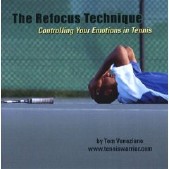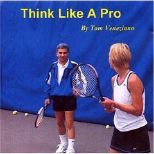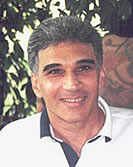Players are always worried that training with repetition and little technique will develop the unacceptable, often maligned bad habit. They believe you cannot play tennis well if you have bad habits. Right? Wrong!
All players in the sport of tennis are playing with bad habits. No one is playing correctly. Want proof? Watch your peers play. Do you think every time they make shots they are hitting exactly right? I don't think so! Yet you do not hear a peep out of them until the dreaded and fatal miss. Now suddenly they have a bad habit that needs rehabilitation. Remember to tell the pro about that one in the next lesson! Never mind that they just successfully made the shot five times in a row with the same bad habit. When the ball went in the court there was no bad habit.
But be of good cheer. All the pros have bad habits just like we do! Since their balls go in much of the time, no one is going to call them out on any bad habits. In fact, knowing that I teach with little technique and lots of repetition, people frequently ask me about developing bad habits. My answer is always the same. What bad habits would you like? Nadal's hitting off the back foot? Federer's straight-armed forehand, Roddick's head coming down on his serve or Simon's knees not bending on his groundstrokes? The list is endless!
I have done my best to help players understand that, within common sense and reason, there are no bad habits. If you keep hitting and master that bad habit shot it will no longer be a bad habit. Instead, that shot becomes a unique weapon in your tennis arsenal. If you manage to become a top pro with that same bad habit, no one will even care the bad habit is there! In fact, your bad habit will probably be regarded as the newest shot or technique to master and everyone will want to emulate it. It is amazing how success can make a so-called bad habit right!
Gilles Simon, a top-ranked pro in the world, does not bend his knees much when he hits his groundstrokes. In the early rounds of an ATP tournament, this became a topic of conversation for the tournament's commentators. They made comments like, "He is going to have some problems being so upright when he plays," or "He is just so straight-legged. Was he not taught to bend his knees?" Even the commentators are susceptible to this bad habit misconception!
Match after match, Simon kept winning and winning. The negative comments became less and less. In the finals, Simon was winning rather easily and now the comments became, 'You know it looks like all the players but Simon are tired. Maybe they are spending too much energy bending their knees." I could not believe what I was hearing! Because Simon was winning (and he did win in the finals) whatever he was doing was now right. Just the previous week his play was all wrong! Now the commentators began thinking that bending the knees may not be that good because it could make a player tired. Amazing!
We all tend to think this way on the tennis court. Our bad habits are not bad habits if the ball goes in the court. I'm sure if Gilles Simon would have lost in the first round the commentators would have said that his problem was not bending his knees. If he loses, not bending the knees is a problem. But if he wins, not bending the knees is fantastic!
If you are practicing with repetition and not much technique, you do not have to worry about developing a bad habit. The body has an unbelievable ability to seek efficiency and a stable equilibrium if you are patient and give it a chance.
Take a look at Francoise Durr's backhand. She held a forehand grip to hit all her backhands. You may be thinking, "So what? Players use a forehand grip on two-handed backhands all the time." True, but Francoise Durr had a one-handed backhand! How well did she do with this awkward grip? She reached number three in the world in the 1960's and 70's, was in the top ten for ten straight years and won the French Open. All with... yes, one of the worst bad habits I have ever seen! But the body still adapted.
http://www.tennisforum.com/showthread.php?t=15175
- Scroll down to second set of pictures. Incredible!
Repetition and only repetition can take good shots and bad habit shots and turn them into winning formulas. The power of repetition coupled with the dynamics of the body can take almost any shot you possess and mold it into a great shot. But you first must conquer the bad habit misconception and adopt the correct perspective. The best pros in the world have done this, now it is your turn.










 You will join 13,000 other subscribers in receiving news of updates to the Tennis Server along with monthly tennis tips from tennis pro Tom Veneziano.
You will join 13,000 other subscribers in receiving news of updates to the Tennis Server along with monthly tennis tips from tennis pro Tom Veneziano. 